Challenging the digital status quo at Cranfield University’s DARTeC
- Like
- Digg
- Del
- Tumblr
- VKontakte
- Buffer
- Love This
- Odnoklassniki
- Meneame
- Blogger
- Amazon
- Yahoo Mail
- Gmail
- AOL
- Newsvine
- HackerNews
- Evernote
- MySpace
- Mail.ru
- Viadeo
- Line
- Comments
- Yummly
- SMS
- Viber
- Telegram
- Subscribe
- Skype
- Facebook Messenger
- Kakao
- LiveJournal
- Yammer
- Edgar
- Fintel
- Mix
- Instapaper
- Copy Link
Posted: 1 March 2021 | Leah Hockley (International Airport Review) | No comments yet
Set to open in 2021, the Digital Aviation Research and Technology Centre (DARTeC) at Cranfield University aims to bring together sector leads from across the aviation industry within a collaborative research environment to create, experiment and challenge the digital status quo. International Airport Review’s Junior Editor, Leah Hockley, spoke with three academics from the centre – Dr Saba Al-Rubaye, Dr Thomas Budd and Dr Dimitrios Panagiotakopoulos – about their roles, the research that they are undertaking and what they hope to achieve by working at DARTeC.
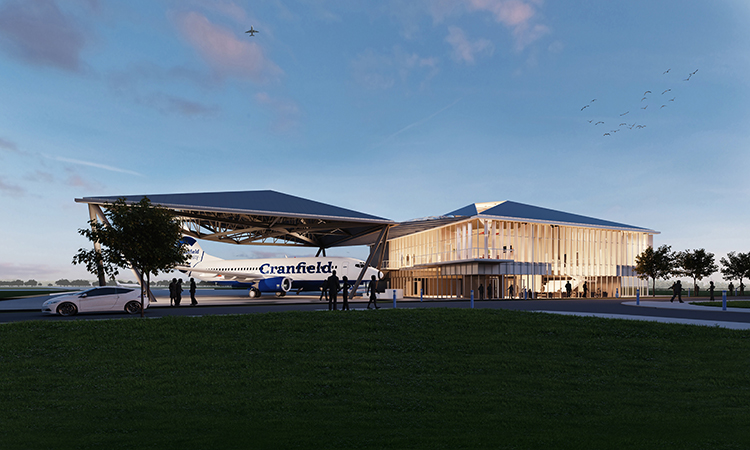

An artist impression of the new DARTeC building.
In a pre-pandemic world, before COVID-19 completely eliminated passenger demand and all associated revenues, aviation was one of the most thriving and economically beneficial industries in the world. In the UK alone, aviation contributed £52 billion to UK Gross Domestic Product (GDP), supported 961,000 jobs and generated £19.8 billion in tax revenues each year.
Prior to the pandemic, UK passenger numbers were expected to increase by a further 49 per cent by 2050, and a similar picture was echoed across Europe and the rest of the world. But the pace of air travel growth was already beginning to cause strains across the sector. Without quick and significant changes, the projected growth in passenger numbers was expected to result in an increase in travel time losses and cause greater social dissatisfaction with the sector.
Digital aviation
Digital aviation (or ‘Aviation 4.0’) has been considered as being the next significant business transformation within the sector, and one which can support the industry towards delivering greater customer satisfaction whilst addressing efficiency, cost and capacity issues.
Digital technologies and connectivity are creating new opportunities that benefit the full value chain”
Digital aviation can mean many things. At its simplest, it is about harnessing and processing data through increasingly autonomous, connected and intelligent systems to improve efficiency, capacity, safety, cost and other service targets. Digital technologies and connectivity are creating new opportunities that benefit the full value chain, from manufacturing to operations, and from major corporates to individual passengers.
Any digital aviation initiatives that are undertaken need to deliver benefits that are clearly understood by the end-users – passengers or freight forwarders. One such significant benefit is on-time performance. An analysis of contributions to journey delays has shown that over 60 per cent of the factors that have caused delays in the past have a digital (data flow) connection and that no one part of the sector is the dominant root cause.
In a pre-pandemic world, before COVID-19 completely eliminated passenger demand and all associated revenues, aviation was one of the most thriving and economically beneficial industries in the world. In the UK alone, aviation contributed £52 billion to UK Gross Domestic Product (GDP), supported 961,000 jobs and generated £19.8 billion in tax revenues each year.
Prior to the pandemic, UK passenger numbers were expected to increase by a further 49 per cent by 2050, and a similar picture was echoed across Europe and the rest of the world. But the pace of air travel growth was already beginning to cause strains across the sector. Without quick and significant changes, the projected growth in passenger numbers was expected to result in an increase in travel time losses and cause greater social dissatisfaction with the sector.
Digital aviation
Digital aviation (or ‘Aviation 4.0’) has been considered as being the next significant business transformation within the sector, and one which can support the industry towards delivering greater customer satisfaction whilst addressing efficiency, cost and capacity issues.
Digital technologies and connectivity are creating new opportunities that benefit the full value chain”
Digital aviation can mean many things. At its simplest, it is about harnessing and processing data through increasingly autonomous, connected and intelligent systems to improve efficiency, capacity, safety, cost and other service targets. Digital technologies and connectivity are creating new opportunities that benefit the full value chain, from manufacturing to operations, and from major corporates to individual passengers.
Any digital aviation initiatives that are undertaken need to deliver benefits that are clearly understood by the end-users – passengers or freight forwarders. One such significant benefit is on-time performance. An analysis of contributions to journey delays has shown that over 60 per cent of the factors that have caused delays in the past have a digital (data flow) connection and that no one part of the sector is the dominant root cause.
The conclusion is that, to make a step-change in addressing the on-time performance challenge, then not only should new digital solutions be developed, but they must be fully integrated across the entire aviation spectrum. It is in solving this digital systems integration challenge where the greatest benefits might be realised.
The Digital Aviation Research and Technology Centre (DARTeC)
DARTeC will be a world-class centre for the research and development of cross‑sector digital integration solutions”
DARTeC, which is being built at Cranfield University in the UK, will be a world-class centre for the research and development of cross‑sector digital integration solutions. Co-funded by Research England – an industry consortium of leading aviation organisations and Cranfield University – the centre is a £65 million investment in state-of-the-art facilities that will leverage both the University’s airport and its newly opened autonomous vehicle research facility.
The centre is an innovative opportunity to bring together sector leads from across the aviation industry (airspace management, airport, airline and aircraft) within a collaborative research environment to create, experiment and challenge the digital status quo through accelerating digital systems integration.
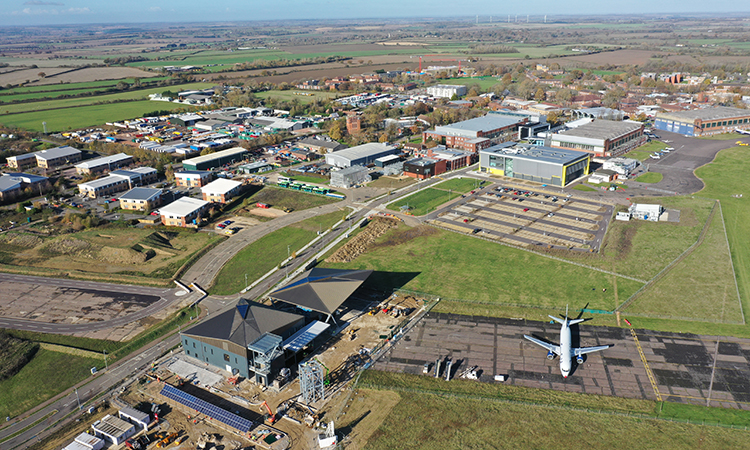

DARTeC and the Cranfield University campus.
DARTeC will initially focus on five primary research challenges within an organisational resilience framework that individually have direct relevance to the digital agenda, and collectively provide the opportunity to explore and address systems integration challenges through advances in technology, intelligence, regulatory frameworks and business models. These are:
- Seamless passenger experience
- Unmanned traffic management
- Distributed airport/airspace management
- Connected systems
- Conscious aircraft.
The facility will consist of a central building containing a suite of digital aviation research laboratories, a partially covered ‘hangar laboratory’, a 737-400 aircraft, an intelligent movement area and a remote air traffic control centre with conventional and advanced holographic radar systems that are capable of monitoring and controlling the airspace around Cranfield’s airport.
Located adjacent to the DARTeC central building, the hangar laboratory will house Cranfield’s 737‑400 aircraft, which will be connected through an airport-style air-bridge. The hangar laboratory will include: Aircraft sensing equipment; visual, thermal and load distribution; and, for digital maintenance, repair and overhaul (MRO) studies and markings for an airport gate. The laboratory will house airport ground handling vehicles, where assistive digital technologies will be researched and integrated to improve ground operation efficiency and safety. In addition, the facility will enable research into the development of fully autonomous ground handling vehicles and the application of unmanned aerial vehicles (UAVs) for remote inspection concepts.
Seamless passenger experience
Dr Tom Budd is a lecturer in Airport Planning and Management at the Centre for Air Transport Management at Cranfield University, as well as one of the academic leads for one of the five key themes within DARTeC – the seamless passenger experience.
Overall, the remit of the theme, the seamless journey itself, is around how we can utilise disruptive digital technologies to try and create seamless, safe and sustainable journeys for passengers, but also for aircraft and for cargo”
“The seamless journey itself is actually split into three main components. Overall, the remit of the theme, the seamless journey itself, is around how we can utilise disruptive digital technologies to try and create seamless, safe and sustainable journeys for passengers, but also for aircraft and for cargo. We have currently two laboratories that we have already set up relating to those different aspects, with one future lab hopefully coming after DARTeC launches. At the moment, we have the passenger experience laboratory, which obviously relates to the passenger experience, and that will form one of the largest physical laboratories at DARTeC. We also have our ground operations laboratory, and that revolves around seamless aircraft journeys,” Budd said.
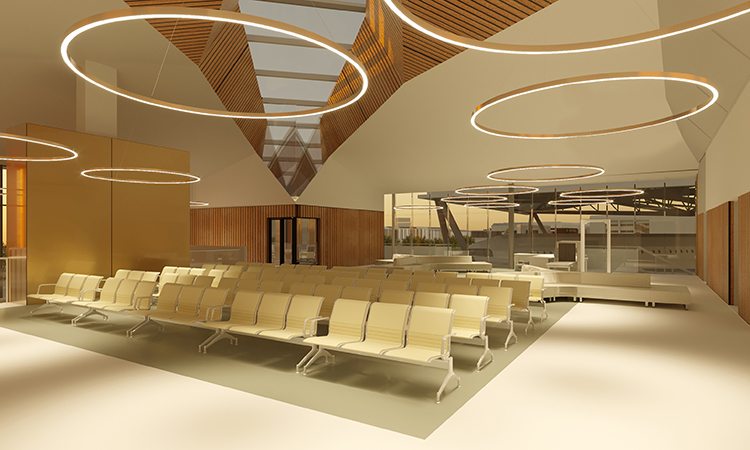

The DARTeC passenger experience lab.
When asked about the importance of the seamless passenger experience, Budd explained: “So, bearing in mind what has been happening with COVID-19 and the devastating impact that it is having on air transport, I think there is still a significant prevailing challenge around how we, as stakeholders in the industry, can facilitate a more seamless, door-to-door travel experience. The first step is recognising that the air travel experience is not just when on the aircraft, but is a door-to-door experience from the point at which the passenger considers booking their flight all the way through to the point in which they arrive at their destination. So, it’s a recognition and a realisation of that.”
We are looking at how we can improve the passenger experience for essentially everyone in a way that makes that door-to-door journey far more inclusive and accessible”
After being asked about the specifics of the research, Budd highlighted the work that is being undertaken to develop the door-to-door experience for everyone, and, in particular, passengers with additional mobility requirements. The seamless passenger experience should be developed for everyone, and Budd stressed that there needs to be a particular focus on making the journey both accessible and inclusive: “We are doing quite a bit of work looking at some of the requirements for passengers with additional mobility needs. This extends far beyond the traditional view of the passengers with reduced mobility (PRMs). We are looking at it far more broadly in terms of that there are a whole host of passengers with unseen disabilities – things like autism, dementia (which is linked to our ageing population) and passengers who may have visual or hearing impairments. We are looking at how we can improve the passenger experience for essentially everyone in a way that makes that door-to-door journey far more inclusive and accessible. I think that there are actually still processes which have almost become accepted in aviation and transport that are not particularly accessible or inclusive in a way that they perhaps should be,” he added.
Commenting on the wider efforts of the seamless passenger experience team at DARTeC, Budd explained: “We see technological advancements all the time. I mean, the rapidly changing nature of technology, and not just in aviation, is huge. But there are questions around how we can best utilise these advances and this technology to enhance the passenger experience in a way that’s operationally efficient, but also, crucially, one that’s financially viable. And, of course, when we start talking about anything that involves putting technology onto an aircraft, or even into the airport terminal building, there are obviously safety and compliance questions and challenges around that. So, the work that we’re doing at DARTeC is trying to address those issues in a way that works for the industry and works for us.”
Unmanned traffic management
Dr Dimitrios Panagiotakopoulos is a senior lecturer currently researching the digitalisation of air traffic management (ATM) and leading the unmanned traffic management (UTM) stream at DARTeC.
ATM is a historically procedural and process-oriented industry that has recently started to implement more automated tools and mechanisms to optimise these processes and support decision making at all levels”
When asked about his role at the centre and the work that the unmanned traffic management stream is undertaking, Panagiotakopoulos outlined: “Within DARTeC, I am looking at the digitalisation of air traffic management. It’s a historically procedural and process-oriented industry that has recently started to implement more automated tools and mechanisms to optimise these processes and support decision making at all levels. It’s all about how we provide timely and accurate data to our stakeholders for accurate and sound decision making. However, in particular, I’m leading the unmanned traffic management research in DARTeC, which looks at developing ecosystems and enabling technologies to allow for the new entrants, for example, of unmanned aircraft systems, remotely piloted aircraft and, generally, autonomous vehicles of the future to be safely, orderly and expeditiously integrated into the existing airspace seamlessly, without any adverse impact to the existing manned aviation and airspace.”
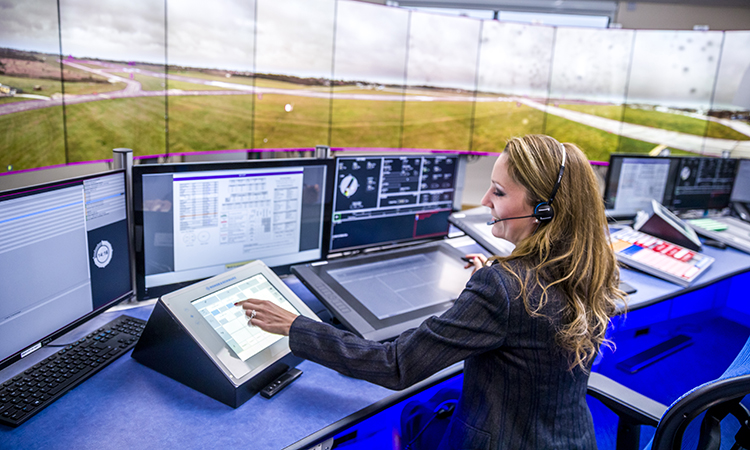

DARTeC will explore how to integrate unmanned traffic management (UTM) with conventional air traffic management (ATM).
“One of the challenges of this is how you integrate unmanned traffic management with conventional air traffic management. Because, in general, air traffic controllers have legal licenses that can be taken from them if there is any sort of incident that was caused by them. So, they are very protective, of course, of that. The challenge is how then you increase traffic levels with unmanned and autonomous systems in a conventional air space, making sure that you don’t affect that system. In particular, right now, air traffic controllers are saying that they don’t want to see or know what any of those unmanned aircraft systems are as it is not their responsibility. So, that’s the challenge that we’re trying to address, and, at DARTeC, we are aiming to unlock the full potential of unmanned aircraft systems (UAS) applications by developing an effective, usable, modular and scalable technology agnostic UTM architecture that seamlessly allows for the co-existence of the new entrants with the existing air traffic without affecting it,” he continued.
At DARTeC, we are aiming to unlock the full potential of unmanned aircraft systems applications by developing an effective, usable, modular and scalable technology agnostic UTM architecture”
Discussing the unmanned traffic management stream and its purpose further, Panagiotakopoulos said: “The aspiration is to make DARTeC the go‑to place for UTM and Urban Air Mobility (UAM) research and innovation in order to showcase the benefits of UTM and UAM. Especially to tackle its major challenges and inspire the new generation of students to get involved and contribute to the development of their solution. We’re enabling that by developing a technological agnostic ecosystem where all partners, stakeholders and interested parties can come and develop or test their concepts, systems and solutions in a near live environment. By having the airport beside DARTeC and working together, we can take things from a very low technology readiness level (TRL) – so, from the conceptual idea, all the way through development to real-life testing. So, at any point, even if there is a solution already in place that just needs validation in a real-life environment, we can also do that. So, it’s really about working with partners and stakeholders to drive the industry forward from concept development to real-life scenario validation at all stages. That allows us to provide a platform where lessons can be learned and shared, where all of the stakeholders then can collaboratively work together on pressing issues and major challenges and drive the industry forward.”
Connected systems
Dr Saba Al-Rubaye is a senior lecturer in Autonomous and Connected Systems at Cranfield University, and she is currently leading the connectivity and future network research within the connected systems research group at DARTeC.
The main vision of this initiative is to unlock the value of industries and academia by enabling collaborative research experimentation and demonstration for a future and existing connectivity and network system”
Discussing the role of the connected systems stream at the centre, Al-Rubaye explained: “Connected systems relates to communication and future networking. The main vision of this initiative is to unlock the value of industries and academia by enabling collaborative research experimentation and demonstration for a future and existing connectivity and network system, in general. The connected system stream is mainly focusing on ground to air and air to air communications. In this field, particularly, we are investigating the most present technologies and how these technologies can be integrated with different systems in a reliable and secure manner. So, the problem here is how to maintain connectivity and how to make the system secure and reliable for aircraft, drones and urban mobility, such as a flying taxi, in the future.”
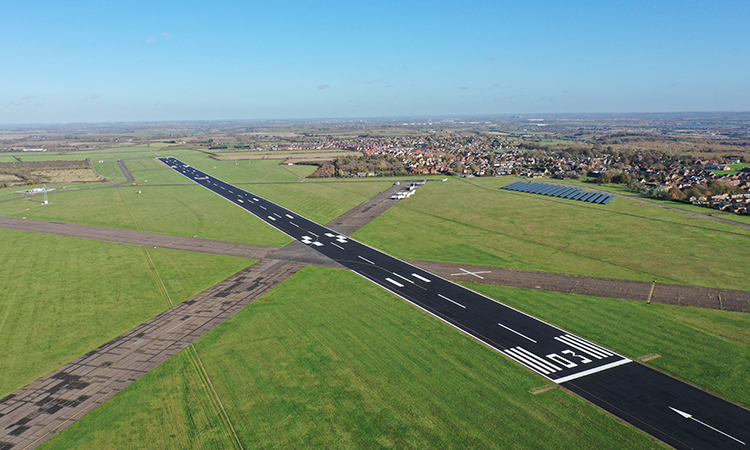

The Cranfield Airport runway.
“The future of the aviation sector will rely mainly on connectivity, on the data exchange between the aircraft and the ground station or between aircraft and aircraft. My research involves different approaches, including visibility studies, system analysis, modelling and simulation, laboratory testbeds, field measurements, and also system prototypes and field testing, as well. The connectivity stream at DARTeC will continue to develop additional capabilities, as well, from new partners, or collaborate on different aspects with other universities. We are also aiming to create or obtain new project ideas, looking to the future and not being restricted to existing technology,” she added.
Explaining her role and the purpose of the connected systems stream further, Al-Rubaye continued: “We are researching digital aviation connectivity in order to facilitate different things. First of all, DARTeC is a new facility which is considered as a national hub for Unmanned Aircraft System Traffic Management drones, air traffic control (ATC) aircraft, or flying taxi hubs in urban cities in the near future. That can also play an important role, not only for the UK, but also perhaps for the European region, or even internationally. So, we are looking at the future of flight connectivity and what this will look like. We also encourage and improve the quality of research development by doing more collaborative research with our industrial partners. So, I would say that what makes us unique is that we can undertake research and verify concepts using real industrial platforms to provide a solution for the aviation sector.”








Issue
Related topics
Air traffic control/management (ATC/ATM), Aircraft, Airside operations, COVID-19, Digital transformation, Drones, New technologies, Passenger experience and seamless travel, Passengers with reduced mobility (PRMs), Safety, Terminal operations
Related organisations
Cranfield University, Digital Aviation Research and Technology Centre (DARTeC)


















